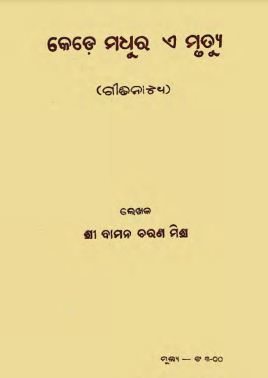Published in 1984, “Kede Madhura E Mrutyu” by Baman Charan Misra is a significant addition to Odia literature that intricately blends history with opera, capturing the essence of legendary figures and events. The book is a vivid portrayal of Sikander, the great conqueror, and offers a unique perspective on his life, adventures, and the socio-political landscape of the era.
At its core, “Kede Madhura E Mrutyu,” which translates to “Where Sweetness Meets Death,” delves into the life and exploits of Alexander the Great, or Sikander, as he is known in many Indian narratives. Misra’s work is notable for its detailed research and historical accuracy, painting a comprehensive picture of Sikander’s encounters in India, particularly his interactions with the local kingdoms.
Misra sets the stage by juxtaposing the grandeur of Sikander’s conquests with the rich culture and heritage of Odisha. This dual narrative creates a tapestry of conflict, ambition, and cultural exchange that reflects the complexities of historical encounters between civilizations.
A distinctive theme in “Kede Madhura E Mrutyu” is the exploration of mortality and legacy. The title suggests a philosophical inquiry into the transient nature of life and the sweet yet fleeting nature of power and glory. Through the lens of historical events, Misra delves into how great leaders grapple with their mortality amidst their pursuits of dominance, urging readers to contemplate the true essence of life and success.
Moreover, the book also touches upon themes of love, betrayal, and the moral dilemmas faced by those in power. Misra doesn’t shy away from showcasing the human side of his characters, including Sikander, who is often portrayed as a distant, almost mythical figure. By humanizing these historical personas, he allows readers to engage with their stories on a deeper emotional level.
Baman Charan Misra’s literary style in “Kede Madhura E Mrutyu” is marked by its lyrical quality, reminiscent of traditional operatic narratives. The blend of poetry, dialogue, and action captures the essence of a dramatic performance, inviting readers to visualize the unfolding events as if they were part of a grand theatrical production.
The use of vibrant imagery and rich descriptions breathes life into the historical setting, giving readers a sense of the sights, sounds, and emotions of the time. Misra’s ability to weave historical facts into evocative narrative creates a compelling reading experience that transcends mere documentation.
“Kede Madhura E Mrutyu” holds a significant place in Odia literature as it revives interest in historical narratives, particularly those that highlight India’s diverse past. By focusing on a prominent figure like Sikander, Misra emphasizes the importance of understanding history from multiple perspectives, encouraging readers to reflect on the lessons that can be drawn from the past.
The book also serves as a bridge connecting modern Odia readers to their historical roots, fostering a sense of pride in cultural heritage and identity. Misra’s work contributes to the broader discourse on how history is interpreted and represented in literature, prompting discussions on the power dynamics and cultural exchanges that have shaped human civilization.
In conclusion, “Kede Madhura E Mrutyu” by Baman Charan Misra is more than just a historical opera; it is a profound exploration of the human experience through the lens of history. By masterfully combining elements of drama, poetry, and historical analysis, Misra invites us to reflect on the ephemeral nature of life and the enduring quest for meaning amidst the grand narratives of conquests and legacies. This book remains an important work in Odia literature, inspiring generations to appreciate the beautiful complexity of our historical roots.
Books Info
| Books name | Kede Madhura E Mrutyu/କେଡେ ମଧୁର ଏ ମୃତ୍ୟୁ |
| Editor | Baman Charan Misra |
| No Of pages | 44 |
| Publisher | NA |
| Publication | 1984 |
| Printed At | New Town Press |
| Distributor | NA |

